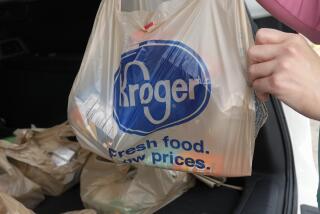Wal-Mart Seeks Approval to Buy Thrift
CHICAGO — Wal-Mart Stores Inc., the world’s No. 1 retailer, is seeking regulatory approval to buy a bank in the United States, as it moves to expand its blue-chip name into a new area of business.
In a filing released by the Office of Thrift Supervision on Tuesday, Wal-Mart said it wants to buy Federal BankCentre, an Oklahoma savings bank, to create a “marriage of a retail banking business to a new and large customer base.”
Wal-Mart said its three-year business plan calls for opening five bank branch offices at Wal-Mart Supercenters to serve as a test for expansion. Wal-Mart Supercenters, which number nearly 600 in the U.S., combine full-line supermarkets with discount department stores.
The Bentonville, Ark.-based company already leases space to other banks in many of its larger stores.
“Large banking institutions have not always provided the full range of cost-effective services to the people who need those services the most. The purchase of FBC will allow Wal-Mart to address these needs,” Wal-Mart said.
Retail industry analyst Kurt Barnard said offering banking services to customers already in Wal-Mart stores would be a logical expansion of the company’s retail powerhouse.
“The time has come for this, and given the fact that Wal-Mart is behind it, it is likely to be successful,” said Kurt Barnard, publisher of Barnard’s Retail Trend Report.
Wal-Mart certainly has enough cash to fund a bank. At the end of the company’s fiscal first quarter April 30, Wal-Mart had nearly $2 billion in cash and cash equivalents on its balance sheet.
Wal-Mart operates more than 4,000 stores, including Wal-Marts, Sam’s Clubs and Supercenters. Its stock closed Tuesday at $46.81, up $1.25, on the New York Stock Exchange. The thrift filing was released after the close of U.S. markets.
In the filing, Wal-Mart said its goal is to “build a financial services bridge” to existing customers and enhance customer service.
But the application is certain to draw opposition from community banks that would find it hard to compete with Wal-Mart’s geographic reach and financial muscle.
Rep. Steve Largent (R-Okla.), who has led efforts in the House to bar commercial firms from buying thrifts, said the move “underscores the threat to the small-town banker and the wrongheadedness of moving down this path of mixing commerce and banking.”
By law, commercial firms generally may not own national banks but can operate a single thrift. This so-called unitary thrift loophole has been a focus in current congressional efforts to overhaul Depression-era banking laws.
As part of a broader banking bill likely to be taken up Thursday, the House has proposed barring any new unitary thrifts and giving the Federal Reserve a say in whether existing ones can be bought by commercial firms.
Small bank groups say that doesn’t go far enough and that Congress needs to halt the kind of linkages between big business and banking now being blamed for some of the economic problems in countries such as Japan.
“We need to secure the passage of legislation that closes down this loophole,” said Ken Guenther, executive vice president of the Independent Community Bankers of America.
A final decision on the application from the OTS, which regulates the U.S. thrift industry, is expected to take many months.
Wal-Mart isn’t the only retailer seeking to own a thrift. Federated Department Stores Inc., the Cincinnati-based owner of Macy’s and Bloomingdale’s, and Seattle-based Nordstrom Inc. also have applications pending before the OTS.
More to Read
Inside the business of entertainment
The Wide Shot brings you news, analysis and insights on everything from streaming wars to production — and what it all means for the future.
You may occasionally receive promotional content from the Los Angeles Times.










